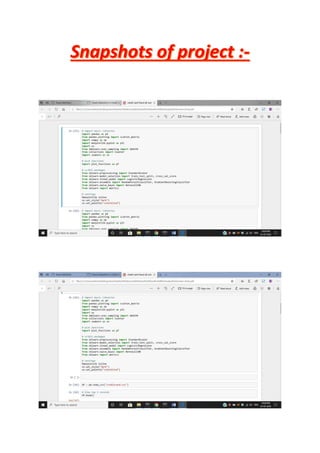

- #CREDIT CARD VALIDATOR PYTHON PROJECT FOR FREE#
- #CREDIT CARD VALIDATOR PYTHON PROJECT HOW TO#
- #CREDIT CARD VALIDATOR PYTHON PROJECT PDF#
- #CREDIT CARD VALIDATOR PYTHON PROJECT MANUAL#
- #CREDIT CARD VALIDATOR PYTHON PROJECT SERIES#
#CREDIT CARD VALIDATOR PYTHON PROJECT PDF#
You can easily export PDF for the Application,Credit Card, Consumer.Provide filter reports on Limits, Consumer, Document.It generates the report on Application, Cibil Reports,Credit Card.Integration of all records of Document.Editing, adding and updating of Records is improved which results in proper resource management of Application data.It deals with monitoring the information and transactions of Consumer.

#CREDIT CARD VALIDATOR PYTHON PROJECT MANUAL#
The purpose of the project is to build an application program to reduce the manual work for managing the Application, Cibil Reports, Credit Card, Limits. The project is totally built at administrative end and thus only the administrator is guaranteed the access.

It manages all the information about Application, Credit Card, Document, Application. The main objective of the C++ Project on Credit Card Approval System is to manage the details of Application, Cibil Reports, Limits, Consumer, Document. Share your experience and queries through comments.Objective of C++ Project on Credit Card Approval System
#CREDIT CARD VALIDATOR PYTHON PROJECT FOR FREE#
What are you waiting for? Start learning the machine learning concepts for FREE with the help of DataFlair’s Machine Learning Tutorial Series. Machine Learning and R are the important technologies of this decade and will last forever. So, now you are ready to detect the fraud. We learnt how data can be analyzed and visualized to discern fraudulent transactions from other types of data. We used a variety of ML algorithms to implement this model and also plotted the respective performance curves for the models.
#CREDIT CARD VALIDATOR PYTHON PROJECT HOW TO#
Gbm_auc = roc(test_data$Class, gbm_test, plot = TRUE, col = "red")Ĭoncluding our R Data Science project, we learnt how to develop our credit card fraud detection model using machine learning. Gbm_test = predict(model_gbm, newdata = test_data, n.trees = gbm.iter) = TRUE)Ĭode: # Plot and calculate AUC on test data Gbm.iter = gbm.perf(model_gbm, method = "test")Ĭode: model.influence = relative.influence(model_gbm, n.trees = gbm.iter, sort. # Determine best iteration based on test data

, action = nrow(train_data) / (nrow(train_data) + nrow(test_data)) We will implement gradient descent algorithm in our model as follows – These decision trees combine together to form a strong model of gradient boosting. This model comprises of several underlying ensemble models like weak decision trees. Gradient Boosting is a popular machine learning algorithm that is used to perform classification and regression tasks. We are importing the datasets that contain transactions made by credit cards. Stay updated with latest technology trends The dataset used in this project is available here – Fraud Detection Dataset By the end of this machine learning project, you will learn how to implement machine learning algorithms to perform classification. We will use a variety of machine learning algorithms that will be able to discern fraudulent from non-fraudulent one. The aim of this R project is to build a classifier that can detect credit card fraudulent transactions. Machine Learning Project – How to Detect Credit Card Fraud For carrying out the credit card fraud detection, we will make use of the Card Transactions dataset that contains a mix of fraud as well as non-fraudulent transactions. We will go through the various algorithms like Decision Trees, Logistic Regression, Artificial Neural Networks and finally, Gradient Boosting Classifier. In this R Project, we will learn how to perform detection of credit cards. Earlier we talked about Uber Data Analysis Project and today we will discuss the Credit Card Fraud Detection Project using Machine Learning and R concepts.
#CREDIT CARD VALIDATOR PYTHON PROJECT SERIES#
This is the 3rd part of the R project series designed by DataFlair. We offer you a brighter future with FREE online courses Start Now!!


 0 kommentar(er)
0 kommentar(er)
